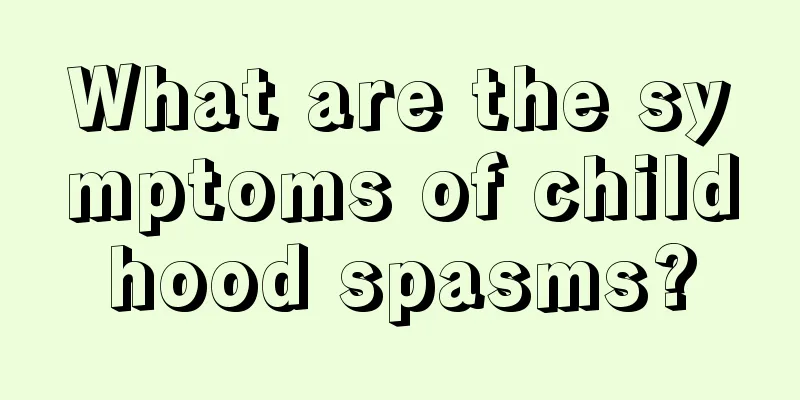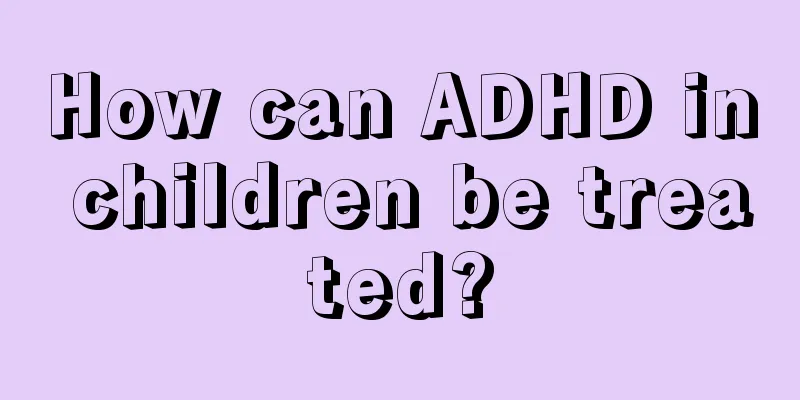What are the symptoms of childhood spasms?

|
Infantile spasms is a relatively common disease. So what are the symptoms of infantile spasms? I believe many friends want to learn about this knowledge. Next, this article will introduce you to the symptoms of infantile spasms. Friends who want to know more about this knowledge can take a look! Please see the detailed introduction below. What are the symptoms of infantile spasms? Infantile spasms begin within 1 year of age and peak at 4 to 7 months. 1. Characteristics of convulsive seizures: Typical seizures are bowing or nodding. Some people have also observed that the disease presents various forms of seizures, such as flexion-hyperextension mixed seizures, which are the most common, and others include flexion, hyperextension, myoclonus, atonia or rigidity, unilaterality, and atypical absence seizures. 1. Bowing spasm: A sudden and brief whole-body muscle spasm occurs, with the trunk and legs bending and the arms stretching forward and outward. 2. Nodding spasm: muscle spasm is limited to the head and neck, with nodding-like attacks occurring, and the forehead and face are prone to bruises. 3. Lightning spasms: They last very short periods of time and can only be noticed by those who happen to be watching the child when they occur. Atypical seizure forms include asymmetric spasms. The head rotates to one side or one side of the limb twitches, there is an extension spasm, the head tilts back, the eyes roll upward, the legs are stretched out, and the legs are in opisthotonos. If a child starts to have cramps such as nodding and bending when he is a few months old, this may be infantile spasms. Infantile spasms are actually a special type of epilepsy in infancy. This disease is more common in infants aged 3-7 months. Its cause may be related to birth trauma, neonatal asphyxia, viral encephalitis, intrauterine infection, congenital toxoplasmosis, congenital brain malformations and certain metabolic diseases. 2. Intellectual changes: When infantile spasms first occur, 60% to 70% of children have intellectual disabilities, which can increase to 85% to 90% when they are 2 years old. Regardless of whether there is intellectual disability before the onset of the disease, intellectual developmental disorders will appear one after another once spasms occur. The diagnosis of this disease can be made based on the characteristics of infantile spasms, EEG peak rhythm disorder, and psychomotor developmental disorders at the onset. The above is an introduction to the symptoms of infantile spasms. I believe that after reading the above introduction, everyone will have a very clear understanding of the related manifestations of infantile spasms. If your child shows the above symptoms, it is very likely that he is suffering from infantile spasms! Therefore, parents must pay close attention to their children's abnormal behavior, and if they find something is wrong, they should seek medical attention in time. |
<<: What to do if your child has a hoarse throat and phlegm
>>: What to do with oral herpes in children
Recommend
What anti-inflammatory medicine is better for children with cough
Every family should have an emergency medicine ki...
What should I do if my seven-month-old child has a high fever?
Babies who have just been born are the most diffi...
At what age is it best for children to start taking calcium supplements?
Children are in the best time of growth and devel...
What are the reasons why children sweat a lot?
Sweating is a normal physiological reaction of th...
Symptoms of purulent meningitis in children
Children's physical health is what parents ar...
Why does a two-year-old baby have a big belly?
Some babies suffer from certain diseases, so they...
How to treat baby's allergic rhinitis?
Because children's physical development is no...
What to do if your baby has loose yellow stools
For children, their gastrointestinal protection a...
Tips for middle school students to lose weight
We all know that internet celebrity faces are qui...
How to effectively treat children's rhinitis?
How to treat children's rhinitis? In fact, th...
What causes dry cough in newborns? The reason turned out to be this
Newborn babies have very weak immunity and are ea...
What should I do if my child gets prickly heat on his back?
Prickly heat has a great impact on people's h...
What causes headaches in children?
Headache on the top of the head is an important m...
What causes red and swollen eyes in children?
Red and swollen eyes are a common symptom in chil...
Can children eat blueberries?
Blueberries have high nutritional value and are r...









